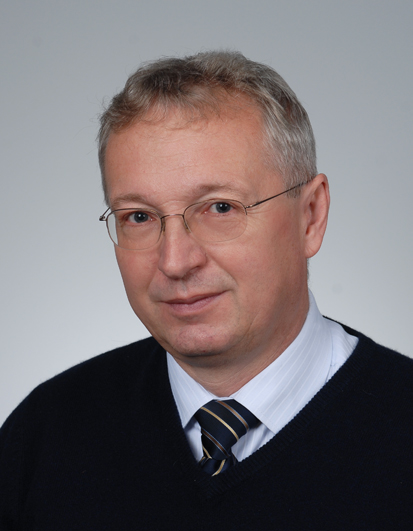Mieczysław Jessa

PhD. Eng. Mieczysław Jessa is employed as a professor at the Poznań University of Technology at the Institute of Multimedia Telecommunications at the Faculty of Computing and Telecommunications. His area of interest initially included issues related to synchronization of the telecommunications network, and later also to the phenomenon of chaos and its application in telecommunications and information technology. Currently, his research interests focus on randomness and pseudo-randomness and the use of both phenomena in various fields, especially for the purposes of cryptography. He is the author of over one hundred twenty articles published in the materials of peer-reviewed journals and conferences, and the author or co-author of fifteen patents.
Contact
Room: 125
Phone: +48 61 665 3854
Mail: mieczyslaw.jessa@put.poznan.pl
Duty hours
Thu 13:30 - 15:00
Fields of interest
The area of interest includes the phenomena of chaos, randomness and pseudorandomness as well as the use of these phenomena in various fields, especially for the needs of cryptography.
Publications
International journals
- Łukasz Matuszewski, Mieczysław Jessa,
A Low-Complexity Start–Stop True Random Number Generator for FPGAs,
Applied Sciences, Vol. 14, No. 13, 2024, pp. 5642-1-5642-11,
Full textEndNoteCitation - Jakub Nikonowicz, Mieczysław Jessa, Łukasz Matuszewski,
Computationally Efficient Wideband Spectrum Sensing through Cumulative Distribution Function and Machine Learning,
Journal of Communications Software and Systems, Vol. 20, No. 1, 2024, pp. 38-46,
Full textEndNoteCitationDOI - Wiktor Woźniak, Mieczysław Jessa,
Selection of Solar Powered Unmanned Aerial Vehicles for a Long Range Data Acquisition Chain,
Sensors, Vol. 21, No. 08, 2021, pp. 2772-1 - 2772-17,
Full textEndNoteCitationDOI - Jakub Nikonowicz, Mieczysław Jessa,
Gaussianity Testing as an Effective Technique for Detecting Discontinuous Transmission in 5G Networks,
IEEE Access, Vol. 9, 2021, pp. 22186-22194,
Full textEndNoteCitationDOI - Jakub Nikonowicz, Mieczysław Jessa,
A novel method of blind signal detection using the distribution of the bin values of the power spectrum density and the moving average,
Digital Signal Processing, Vol. 66, 2017, pp. 18-28,
EndNoteCitationDOI
International conferences
- Jakub Nikonowicz, Mieczysław Jessa,
Wideband Spectrum Sensing Utilizing Cumulative Distribution Function and Machine Learning,
31st International Conference on Software, Telecommunications and Computer Networks, SoftCOM 2023, 21-23.09.2023, Split, Croatia, Croatia, 2023, pp. 1-6,
Full textEndNoteCitationDOI - Paweł Kubczak, Mieczysław Jessa, Michał Kasznia,
Fast Synchronization Algorithm of High-Stability Oscillators to GNSS Signals,
2023 Joint Conference of the European Frequency and Time Forum and IEEE International Frequency Control Symposium, EFTF/IFCS 2023, 15-19.05.2023, Toyama, Japan, Japan, 2023, pp. 1-4,
Full textEndNoteCitationDOI - Paweł Kubczak, Wiktor Woźniak, Jakub Nikonowicz, Łukasz Matuszewski, Mieczysław Jessa,
An Online Platform for Testing and Evaluating Random Number Generators,
29th International Conference on Software, Telecommunications and Computer Networks, IEEE, Split, Hvar, Croatia, 23-25 Sept. 2021,
Full textEndNoteCitationDOI - Jakub Nikonowicz, Mieczysław Jessa,
Stable Field Detection as a New Spectrum Sensing Technique-Performance Evaluation Under Real Radiofrequency Background Noise,
International Conference on Signals and Electronic Systems (ICSES 2018), IEEE, Krakow, Poland, 10-12 Sept. 2018, pp. 201-205,
EndNoteCitationDOI - Paweł Kubczak, Michał Kasznia, Mieczysław Jessa,
Preprocessing for fast synchronization of high-stability oscillators disciplined by GNSS 1 PPS signal,
2018 European Frequency and Time Forum (EFTF), IEEE, Turin, Italy, 10-12 April 2018, pp. 234-239,
EndNoteCitationDOI - Jakub Nikonowicz, Mieczysław Jessa,
Stable field detection as a novel method for blind sensing of weak radio signals,
2nd International Conference on Astrophysics and Particle Physics, San Antonio, USA, 2017, pp. 104-104,
EndNoteCitationDOI - Jakub Nikonowicz, Mieczysław Jessa,
Blind detection methods in cognitive radio - an overview and comparison,
2016 10th International Symposium on Communication Systems, Networks and Digital Signal Processing (CSNDSP), IEEE, Prague, Czech Republic, 20-22 July 2016, pp. 206-211,
EndNoteCitationDOI
2024
- Łukasz Matuszewski, Mieczysław Jessa,
A Low-Complexity Start–Stop True Random Number Generator for FPGAs,
Applied Sciences, Vol. 14, No. 13, 2024, pp. 5642-1-5642-11,
Full textEndNoteCitation - Jakub Nikonowicz, Mieczysław Jessa, Łukasz Matuszewski,
Computationally Efficient Wideband Spectrum Sensing through Cumulative Distribution Function and Machine Learning,
Journal of Communications Software and Systems, Vol. 20, No. 1, 2024, pp. 38-46,
Full textEndNoteCitationDOI
2023
- Jakub Nikonowicz, Mieczysław Jessa,
Wideband Spectrum Sensing Utilizing Cumulative Distribution Function and Machine Learning,
31st International Conference on Software, Telecommunications and Computer Networks, SoftCOM 2023, 21-23.09.2023, Split, Croatia, Croatia, 2023, pp. 1-6,
Full textEndNoteCitationDOI - Paweł Kubczak, Mieczysław Jessa, Michał Kasznia,
Fast Synchronization Algorithm of High-Stability Oscillators to GNSS Signals,
2023 Joint Conference of the European Frequency and Time Forum and IEEE International Frequency Control Symposium, EFTF/IFCS 2023, 15-19.05.2023, Toyama, Japan, Japan, 2023, pp. 1-4,
Full textEndNoteCitationDOI
2021
- Wiktor Woźniak, Mieczysław Jessa,
Selection of Solar Powered Unmanned Aerial Vehicles for a Long Range Data Acquisition Chain,
Sensors, Vol. 21, No. 08, 2021, pp. 2772-1 - 2772-17,
Full textEndNoteCitationDOI - Paweł Kubczak, Wiktor Woźniak, Jakub Nikonowicz, Łukasz Matuszewski, Mieczysław Jessa,
An Online Platform for Testing and Evaluating Random Number Generators,
29th International Conference on Software, Telecommunications and Computer Networks, IEEE, Split, Hvar, Croatia, 23-25 Sept. 2021,
Full textEndNoteCitationDOI
AbstractThis article introduces a new online platform for testing binary random number generators. The growing share of low-complex devices in IoT networks increases the demand for basic authorization and authentication tools, the critical block of which is a secure random number generator. Communication devices, therefore, require designers to carry out time-consuming tests and acquire specialist knowledge of statistical testing in evaluation of their results. To meet the current requirements, we have created a test platform to assess the quality of random strings produced by the generator. The presented solution, based on the proprietary evaluation metric, provides feedback on the properties of the uploaded random sequences. Clear interface provides ease of use and by machine learning in the platform’s backend, along with the increase of processed data, the improved quality of the interpretation delivered by the system is ensured. The operation of the platform has been confirmed experimentally, based on the analysis of hardware generators producing random strings with known properties.
- Jakub Nikonowicz, Mieczysław Jessa,
Gaussianity Testing as an Effective Technique for Detecting Discontinuous Transmission in 5G Networks,
IEEE Access, Vol. 9, 2021, pp. 22186-22194,
Full textEndNoteCitationDOI
AbstractThe paper investigates statistical distribution testing-based detection methods in an intermittent signal detection scenario. The relevance of the research is driven by 5G networks based on packet transmission, incorporating the concept of cognitive radio and adapting spectrum detection methods from Long Term Evolution (LTE) Licensed-Assisted Access (LAA). The conducted study refers to the recently proposed methods based on testing goodness-of-fit (GoF) of statistical distributions, which are compared with a conventional energy detector. The authors examine the applicability of well-known GoF methods in intermittent transmission, as they require reconsideration in 5G communication systems, and investigate the behavior of the innovative energy-based GoF. The experiments are carried out for different transmitter activity factors, i.e., channel occupancy and signal-to-noise ratio (SNR), demonstrating the superiority of the GoF-based methods in general and particularly the invented GoF test over other energy-based detectors for discontinuous signals detection.
2018
- Jakub Nikonowicz, Mieczysław Jessa,
Stable Field Detection as a New Spectrum Sensing Technique-Performance Evaluation Under Real Radiofrequency Background Noise,
International Conference on Signals and Electronic Systems (ICSES 2018), IEEE, Krakow, Poland, 10-12 Sept. 2018, pp. 201-205,
EndNoteCitationDOI
AbstractDetection of unknown and weak signals has become a study of particular importance as a consequence of the ongoing development in digital sensing technologies. Among well-known methods, the one most commonly used is energy detection. In this paper the efficiency of the conventional energy detection is compared with the efficiency of the recently proposed, so-called stable field detection. The comparison concerns pseudorandom, additive white Gaussian noise (AWGN) produced in the simulation experiment and real radiofrequency (RF) background noise measured in industrial, scientific and medical (ISM) band transmission. The background noise samples were acquired from a laboratory room using a software-defined radio platform NI USRP-2900. The reasonability of the proposed detection approach is confirmed by the results achieved in the modeled system.
- Paweł Kubczak, Michał Kasznia, Mieczysław Jessa,
Preprocessing for fast synchronization of high-stability oscillators disciplined by GNSS 1 PPS signal,
2018 European Frequency and Time Forum (EFTF), IEEE, Turin, Italy, 10-12 April 2018, pp. 234-239,
EndNoteCitationDOI
AbstractThis paper presents a novel algorithm for preprocessing of pulses coming from GNSS and signals produced locally by a rubidium oscillator to reduce synchronization time without changing the main algorithm of the control loop. Moving average and Kalman filtration were used as the preprocessing methods. The experimental results for different rubidium oscillators are presented.
2017
- Jakub Nikonowicz, Mieczysław Jessa,
Stable field detection as a novel method for blind sensing of weak radio signals,
2nd International Conference on Astrophysics and Particle Physics, San Antonio, USA, 2017, pp. 104-104,
EndNoteCitationDOI
AbstractSince the discovery of space radio waves in the early 1930s, most astronomical objects have been perceived as radio wavessources. Radio-astronomy observations ultimately consist in measuring the energy received from a distant source, withparticular emphasis on the detection of unknown and weak signals. The most commonly used blind detection method relieson energy detection with noise power estimation. The variability of the radio environment, however, greatly complicates theentire detection process. In order to solve the problem of detection in varying noise conditions, we propose a novel method ofblind signal detection called Stable Field Detection (SFD), which does not require any knowledge of the noise variance. Theproposed method uses the bin value distribution of the received signal’s power spectrum density and the moving average. Itrefers to the mutual relations between the distributions of random variables to extract more information from the spectrumthan normal energy detection. As a result, SFD operates on thresholding Gaussian distribution, which makes it as easy to useas energy detection, but remains much more effective. The simulation results for radio pulses show that the performance ofthe method is significantly improved under the proposed scheme. With regard to weak signals, when compared to the energydetection, the lower limit of the permissible signal-to-noise ratio has been decreased by 4dB. At the same time, the proposedsolution maintains low O (nlogn) computational complexity. SFD is considered a new, effective and simple software defineddetector that addresses the challenges of modern astronomy.
- Jakub Nikonowicz, Mieczysław Jessa,
A novel method of blind signal detection using the distribution of the bin values of the power spectrum density and the moving average,
Digital Signal Processing, Vol. 66, 2017, pp. 18-28,
EndNoteCitationDOI
AbstractSignal detection in additive white Gaussian noise (AWGN) is one of the long-term developments driving the evolution of many different fields of science and technology, with important applications in telecommunications, medicine and astronomy. In this paper, we propose a novel method of blind signal detection that does not require knowledge of the noise variance. This method uses the distribution of the bin values of the power spectrum density of the received signal and the moving average (MAV). The simulation results for radio pulses show that the spectrum sensing performance is significantly improved under the proposed scheme compared to that of known blind signal detection methods.
2016
- Jakub Nikonowicz, Mieczysław Jessa,
Blind detection methods in cognitive radio - an overview and comparison,
2016 10th International Symposium on Communication Systems, Networks and Digital Signal Processing (CSNDSP), IEEE, Prague, Czech Republic, 20-22 July 2016, pp. 206-211,
EndNoteCitationDOI
AbstractCognitive radio (CR) is one of the most important challenges in contemporary communication. Because cognitive technologies are based on matching transmission parameters to the surrounding radio environment, several practical problems related to weak signal detection must be solved. These include, e.g., uncertainty of the noise variance value, the changes of this value in time and space, limited hardware resources or time of detection. All of these factors can seriously degrade system performance. The search for practically useful solutions of the encountered difficulties is therefore very important for the successful development and implementation of CR technology. This article provides an overview and comparison of chosen blind detection methods proposed for use in CR receivers. The comparison is based on simulation results, and the methods are compared in terms of detection efficiency, time complexity and robustness to changes in transmission parameters.
